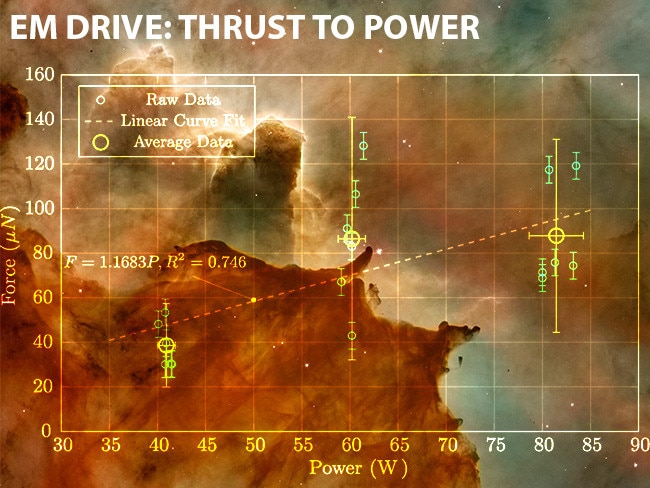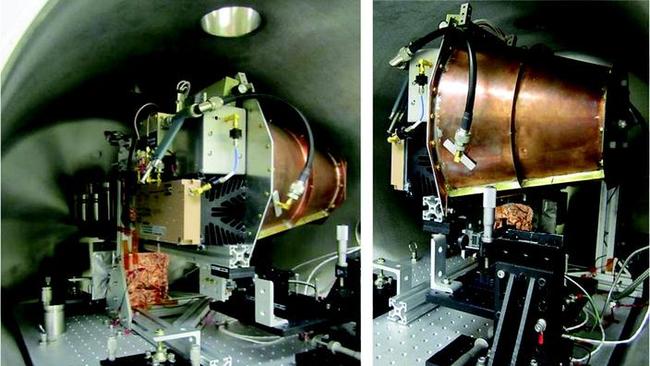Perpedual motion machines have long been the domain of backyard inventors and snake-oil salesmen. This time, though, science hasn’t yet managed to figure out how a prototype space engine manages to produce something from nothing.
So is there something wrong with our understanding of the laws of the universe? Or are we just jumping the gun?
The dream has always been to create a motor that doesn’t need winding, doesn’t need fuel. And yet, once you start it up, it just keeps going — and going.
That’s the dream behind the EM drive prototype currently being examined by NASA.
There’s no fuel. There’s no exhaust. But it seems to produce a steady, tiny amount of thrust.
And that’s where it comes smack up against one of the most tried and tested laws of physics: every action must have an equal and opposite reaction.
This engine doesn’t.
“That would break physics as we know it,” says Swinburne University astrophysicist Dr Alan Duffy.
It’s a thrust so small it’s utterly useless on the ground. But, in space, without the challenges of friction or gravity, it could steadily build up enough momentum to propel a spacecraft to the planets.
That’s the dream.
But our understanding of physics can’t just be tossed aside. So much, from aircraft to space craft, x-ray machines to iPhones, has been built upon it.
So there must be some other force at play.
Perhaps a new kind of complementary physics? Or perhaps some simple oversight that is distorting the tests to produce a misleading result?
BUILDING MOMENTUM
The radio frequency resonant cavity thruster’s inventor, Roger Shawyer, says the evidence his drive works can be easily proven through scientific replication and verification.
Since his first demonstrations in the early 2000s, several labs have certainly given it a shot. They’ve found it does produce tiny amounts of thrust.
They’ve not been able to explain why.
The latest in that line is NASA’s Eagleworks propulsion laboratory. Their comprehensive testing and review process has even passed the stringent peer-review process to be formally published in one of the aerospace industry’s top scientific journals.

The concept of the EM drive is to use electromagnetic microwaves to convert electrical energy directly into thrust.
Dr Duffy says a loose analogy for this is to hammer your kitchen microwave into a cone shape, and turn it on. The microwaves inside bounce back and forth and somehow this results in thrust.
“You’d be surprised if your microwave suddenly flew off … so too are scientists about this ‘EM drive’,” Dr Duffy says.
“These unexpected results are why we do science!”
Assuming it all actually works, Dr Duffy says your standard microwave oven at full power would barely be able to lift a fruit fly. The EM drive has been measured producing thrust of just 2.1mN per kilowatt.
“Such a weak effect is why I’m convinced that there is a subtle reaction force produced that we just haven’t measured yet,” he says.
And when put up against other cutting-edge propulsion technologies, this thrust is insignificant.
“Unfortunately this current EM drive is too weak to compete against NASA’s current ion drives, so we won’t be travelling to the planets much less the stars with this,” Dr Duffy says.
PHYSICS UNDER PRESSURE?
Things move forwards by pushing something backwards. For aircraft that’s air funnelled through their combustion chambers. For a rocket it is propellant being expelled through its exhaust.
“This is Newton’s Third law, every action has an opposite reaction. To move forward you need to push something back,” says Dr Duffy.
The EM drive appears not to.
When it comes to physics, we know what works. And Isaac Newton’s laws of motion have formed the basis of our industrial and technological success for hundreds of years.
Law 1: Unless there is an outside force acting on it, an object at rest remains at rest and an object in motion stays in motion.
Law 2: Force is the rate of change in momentum over time (f=ma)
Law 3: For every action there is an equal and opposite reaction.
Since Newton, testing and further study have found exceptions to, and other influences on, his first two laws — such as Einstein’s law of relativity.
Newton’s third law, however, has held fast across all new realms of physics, be it quantum mechanics or electromagnetism.
If the EM drive works, Newton was wrong.
But so was Einstein and just about every great physicist since and in between.
TOPPLING THE APPLE CART?
So far, nothing has been discovered producing the tiny ‘push’ the EM drive appears to be generating.
As it stands, the EM drive’s mechanics have been compared to a driver sitting in a car and getting it to move by pushing on the windscreen.
Guessing what could be generating the necessary thrust has some theoretical physicists excited.
Is the symmetry of the universe an illusion?
Should we be replacing particle physics with probability states?
Some argue it is possible that what we understand to be the laws of physics actually apply in different ways at different points in space and under different conditions. This would mean the universe isn’t symmetrical. That physics as it applies here, on Earth, may not be the same that applies in, say, the Andromeda galaxy.

And if the laws of physics depend on position, that also topples Einstein’s theory of relativity. Different observers in different frames of reference will see different outcomes.
It also breaks our understanding of particle physics. Energy would have to operate outside the boundaries science has long established.
The answer to the EM drive’s challenge to the physics is that it cannot truly be one.
All have been tested, and proven, time and again. The Large Hadron Collider, for example, has repeatedly demonstrated our established understanding of the conservation of momentum and energy.
So where does the EM drive fit in all this?
As with cold fusion and any number of perpetual motion machines, we simply need better data.
It may be that the engine does have an exhaust; it’s just that we haven’t spotted it yet. A group of Finnish researchers argue the microwaves could be clashing with out-of-phase photons believed to pop in and out of existence in the quantum vacuum of space. This would conform to Newton’s third law, but whether or not it would generate thrust remains a matter of speculation.
But much of the debate surrounds the incredibly low thrust the drive generates. It is easily inside the realms of a glitch — a small, unanticipated, outside influence that produces an effect that can be measured as thrust.
COLD HARD FACTS
Some critics have pointed out that the EM drive generates an electromagnetic field. This could be interacting with the Earth’s own magnetic field, with the balancing effect being picked up by the lab’s sensors.
Dr Duffy says he thinks the expansion effects of heat have not been properly accounted for in the laboratory.
“Looking at the paper I think it’s actually just the experiment heating up and since materials expand as they heat that’s what’s essentially pushing the load measurer,” he says.
“In particular when they turn off the microwaves the force should instantly stop too. Instead it only slowly ramps down — which is exactly what the device cooling down looks like.”
But, given the extremely small numbers being measured in the lab, it’s not easy to account for all these external influences.
“The best test is put this in orbit and switch it on …” he says. “I bet it’ll just float, not able to move anywhere.”
“It’s great to see this being tested, exploring new effects is what science is all about. But extraordinary (physics breaking!) claims need extraordinary evidence.
“And this isn’t close.”

Add your comment to this story
To join the conversation, please log in. Don't have an account? Register
Join the conversation, you are commenting as Logout
Here’s what you can expect with tomorrow’s Parramatta weather
As spring moves into summer what can locals expect tomorrow? We have the latest word from the Weather Bureau.
Here’s what you can expect with tomorrow’s Parramatta weather
As spring moves into summer what can locals expect tomorrow? We have the latest word from the Weather Bureau.